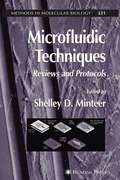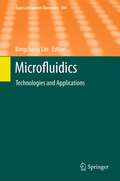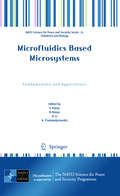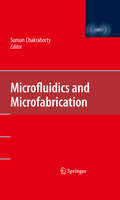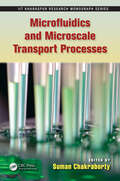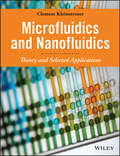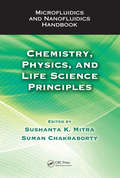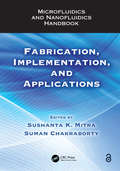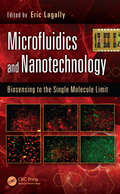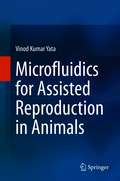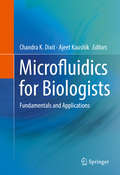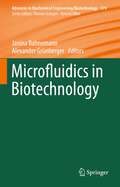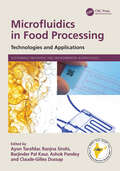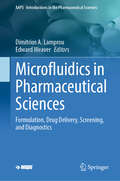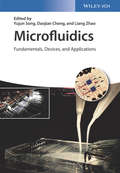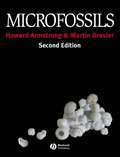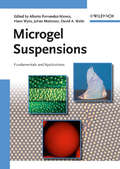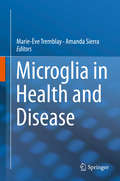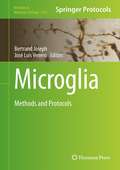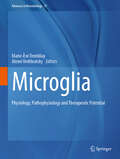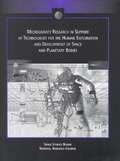- Table View
- List View
Microfluidic Techniques
by Shelley D. MinteerHands-on researchers review the principles behind successful miniaturization and describe the key techniques for miniaturizing large-scale biochemical and bioanalytical methods for microchip analysis. The authors cover not only the most popular methods for the fabrication of microchips (photolithography, laser ablation, and soft lithography), but also microfluidic techniques for such bioanalytical assays and bioprocesses as DNA analysis, PCR, immunoassays, and cell reactors. Highlights include PCR on a microchip, microscale cell culturing, and the study of cellular processes on a microchip. The protocols offer step-by-step laboratory instructions, an introduction outlining the principles behind the technique, lists of the necessary equipment and reagents, and tips on troubleshooting and avoiding known pitfalls.
Microfluidics
by Bingcheng LinFlow Control Methods and Devices in Micrometer Scale Channels, by Shuichi Shoji and Kentaro Kawai. Micromixing Within Microfluidic Devices, by Lorenzo Capretto, Wei Cheng, Martyn Hill and Xunli Zhang. Basic Technologies for Droplet Microfluidics, by Shaojiang Zeng, Xin Liu, Hua Xie and Bingcheng Lin. Electrorheological Fluid and Its Applications in Microfluidics, by Limu Wang, Xiuqing Gong and Weijia Wen. Biosensors in Microfluidic Chips, by Jongmin Noh, Hee Chan Kim and Taek Dong Chung. A Nanomembrane-Based Nucleic Acid Sensing Platform for Portable Diagnostics, by Satyajyoti Senapati, Sagnik Basuray, Zdenek Slouka, Li-Jing Cheng and Hsueh-Chia Chang. Optical Detection Systems on Microfluidic Chips, by Hongwei Gai, Yongjun Li and Edward S. Yeung. Integrated Microfluidic Systems for DNA Analysis, by Samuel K. Njoroge, Hui-Wen Chen, Małgorzata A. Witek and Steven A. Soper. Integrated Multifunctional Microfluidics for Automated Proteome Analyses, by John K. Osiri, Hamed Shadpour, Małgorzata A. Witek and Steven A. Soper. Cells in Microfluidics, by Chi Zhang and Danny van Noort. Microfluidic Platform for the Study of Caenorhabditis elegans,by Weiwei Shi, Hui Wen, Bingcheng Lin and Jianhua Qin.
Microfluidics Based Microsystems
by A. Pramuanjaroenkij B. Kosoy D. Li S. KakaçThis volume provides a comprehensive state-of-the art review of the fundamentals and applications of the microfluidics based microsystems. As the world becomes increasingly concerned with terrorism, early on-spot detection of terrorist's weapons, particularly bio-weapons agents such as bacteria and viruses are extremely important. Microfluidics are great tools for security and anti-terrorism with many applications. New and better diagnostic technology must be developed in order to be prepared for an act of bio-terrorism. Basics of Electrokinetic Microfluidics, Lab-on-a-Chip Devices for Biomedical Applications, Microfluidic Biological Application Specific Integrated Circuits, Integrated Optofluidics and Nanofluidic, Cell Culture Revolution via Dynamical Microfluidic Controls, Fundamentals of droplet flow in microfluidics, Implementation of fluidic functions in digital microfluidics, Chip architecture and applications for digital microfluidics, Mixing in microfluidic systems are presented and discussed in detail. In addition more presentations such as Optofluidics - Fusing Nanofluidics and Nanophotonics, Programmable Matter - Micro and milliscale fluid dynamics of reconfigurable assembly for control of living systems, An Overview on Microfluidic Platforms for Lab-on-a-Chip Applications, Centrifugal Microfluidics for Lab-on-a-Chip Applications are also given. Transport of droplets and bubbles in microfluidic systems - from flow through a simple pipe to logic gates and automated chips for chemical processing, Analytical, Synthesis and Bio-Medical Applications of Microchip Technology, Hydroporetic separation method for blood sample analysis, Magnetophoretic multiplexed immunoassays in a microchannel, programmable particle manipulation using lab-on-a-display, etc. are discussed in details with fundamentals and applications.
Microfluidics and Biosensors in Cancer Research: Applications in Cancer Modeling and Theranostics (Advances in Experimental Medicine and Biology #1379)
by Rui L. Reis David Caballero Subhas C. KunduThis book offers a comprehensive overview of the development and application of microfluidics and biosensors in cancer research, in particular, their applications in cancer modeling and theranostics.Over the last decades, considerable effort has been made to develop new technologies to improve the diagnosis and treatment of cancer. Microfluidics has proven to be a powerful tool for manipulating biological fluids with high precision and efficiency and has already been adopted by the pharmaceutical and biotechnology industries. With recent technological advances, particularly biosensors, microfluidic devices have increased their usefulness and importance in oncology and cancer research.The aim of this book is to bring together in a single volume all the knowledge and expertise required for the development and application of microfluidic systems and biosensors in cancer modeling and theranostics. It begins with a detailed introduction to the fundamental aspects of tumor biology, cancer biomarkers, biosensors and microfluidics. With this knowledge in mind, the following sections highlight important advances in developing and applying biosensors and microfluidic devices in cancer research at universities and in the industry. Strategies for identifying and evaluating potent disease biomarkers and developing biosensors and microfluidic devices for their detection are discussed in detail. Finally, the transfer of these technologies into the clinical environment for the diagnosis and treatment of cancer patients will be highlighted. By combining the recent advances made in the development and application of microfluidics and biosensors in cancer research in academia and clinics, this book will be useful literature for readers from a variety of backgrounds. It offers new visions of how this technology can influence daily life in hospitals and companies, improving research methodologies and the prognosis of cancer patients.
Microfluidics and Microfabrication
by Suman ChakrabortyMicrofluidics and Microfabrication discusses the interconnect between microfluidics, microfabrication and the life sciences. Specifically, this includes fundamental aspects of fluid mechanics in micro-scale and nano-scale confinements and microfabrication. Material is also presented discussing micro-textured engineered surfaces, high-performance AFM probe-based, micro-grooving processes, fabrication with metals and polymers in bio-micromanipulation and microfluidic applications. Editor Suman Chakraborty brings together leading minds in both fields who also: Cover the fundamentals of microfluidics in a manner accessible to multi-disciplinary researchers, with a balance of mathematical details and physical principles Discuss the explicit interconnection between microfluiodics and microfabrication from an application perspective Detail the amalgamation of microfluidics with logic circuits and applications in micro-electronics Microfluidics and Microfabrication is an ideal book for researchers, engineers and senior-level graduate students interested in learning more about the two fields.
Microfluidics and Microscale Transport Processes (IIT Kharagpur Research Monograph Series)
by Suman ChakrabortyThe advancements in micro- and nano-fabrication techniques, especially in the last couple of decades, have led research communities, over the world, to invest unprecedented levels of attention on the science and technology of micro- and nano-scale devices and the concerned applications. With an intense focus on micro- and nanotechnology from a flui
Microfluidics and Multi Organs on Chip
by P. V. MohananThis book highlights the application of microfluidics in cell biology research, chemical biology, and drug discovery. It covers the recent breakthroughs and prospects of organ-on-a-chip, human-on-a-chip, multi-organ-on-a-chip for personalized medicine. The book presents the preclinical studies of organs-on-a-chip, concepts of multiple vascularized organ-on-chips, application of organ-on-a-chip in blood-brain barrier model, culture and co-culture of cells on multi-organ-on-chip and parameter measurements in microfluidic devices. It underscores the advantage of microfluidic devices for developing efficient drug carrier particles, cell-free protein synthesis systems, and rapid techniques for direct drug screening. Further, it entails human-on-a-chip for measuring the systemic response as well as immediate effects of an organ reaction on other organs. In summary, this book reviews the development of a microfluidic-based organ-on-a-chip device for the preclinical evaluation, ADME studies of drugs, chemicals, and medical devices. This book is a valuable source for pharma companies, product developers, students, researchers, academicians, and practitioners.
Microfluidics and Nanofluidics
by Clement KleinstreuerFluidics originated as the description of pneumatic and hydraulic control systems, where fluids were employed (instead of electric currents) for signal transfer and processing. Microfluidics and Nanofluidics: Theory and Selected Applications offers an accessible, broad-based coverage of the basics through advanced applications of microfluidics and nanofluidics. It is essential reading for upper-level undergraduates and graduate students in engineering and professionals in industry.
Microfluidics and Nanofluidics Handbook: Chemistry, Physics, and Life Science Principles
by Suman Chakraborty Sushanta K. MitraThe Microfluidics and Nanofluidics Handbook: Two-Volume Set comprehensively captures the cross-disciplinary breadth of the fields of micro- and nanofluidics, which encompass the biological sciences, chemistry, physics and engineering applications. To fill the knowledge gap between engineering and the basic sciences, the editors pulled together key
Microfluidics and Nanofluidics Handbook: Fabrication, Implementation, and Applications
by Sushanta K. Mitra and Suman ChakrabortyThis comprehensive handbook presents fundamental aspects, fabrication techniques, introductory materials on microbiology and chemistry, measurement techniques, and applications of microfluidics and nanofluidics. The second volume focuses on topics related to experimental and numerical methods. It also covers fabrication and applications in a variety of areas, from aerospace to biological systems. Reflecting the inherent nature of microfluidics and nanofluidics, the book includes as much interdisciplinary knowledge as possible. It provides the fundamental science background for newcomers and advanced techniques and concepts for experienced researchers and professionals.
Microfluidics and Nanotechnology: Biosensing to the Single Molecule Limit (Devices, Circuits, and Systems #27)
by Krzysztof Iniewski Eric LagallyAn increasing number of technologies are being used to detect minute quantities of biomolecules and cells. However, it can be difficult to determine which technologies show the most promise for high-sensitivity and low-limit detection in different applications. Microfluidics and Nanotechnology: Biosensing to the Single Molecule Limit details proven approaches for the detection of single cells and even single molecules—approaches employed by the world’s foremost microfluidics and nanotechnology laboratories. While similar books concentrate only on microfluidics or nanotechnology, this book focuses on the combination of soft materials (elastomers and other polymers) with hard materials (semiconductors, metals, and glass) to form integrated detection systems for biological and chemical targets. It explores physical and chemical—as well as contact and noncontact—detection methods, using case studies to demonstrate system capabilities. Presenting a snapshot of the current state of the art, the text: Explains the theory behind different detection techniques, from mechanical resonators for detecting cell density to fiber-optic methods for detecting DNA hybridization, and beyond Examines microfluidic advances, including droplet microfluidics, digital microfluidics for manipulating droplets on the microscale, and more Highlights an array of technologies to allow for a comparison of the fundamental advantages and challenges of each, as well as an appreciation of the power of leveraging scalability and integration to achieve sensitivity at low cost Microfluidics and Nanotechnology: Biosensing to the Single Molecule Limit not only serves as a quick reference for the latest achievements in biochemical detection at the single-cell and single-molecule levels, but also provides researchers with inspiration for further innovation and expansion of the field.
Microfluidics for Assisted Reproduction in Animals
by Vinod Kumar YataThis book describes the fundamentals of microfluidics and fabrication methods of microfluidic devices that can be adopted for animal-assisted reproduction. It presents microfluidic methods for sorting highly fertile spermatozoa. This book also describes the application of microfluidics in vitro fertilization and embryo culture. It discusses the use of microfluidics in sperm sexing and the cryopreservation of animal gametes and embryos. Lastly, the book examines the potential opportunities of microfluidics in infertility diagnosis, sperm selection and guidance, oocyte selection, insemination, and embryo monitoring.
Microfluidics for Biologists
by Chandra K. Dixit Ajeet KaushikThis book describes novel microtechnologies and integration strategies for developing a new class of assay systems to retrieve desired health information from patients in real-time. The selection and integration of sensor components and operational parameters for developing point-of-care (POC) are also described in detail. The basics that govern the microfluidic regimen and the techniques and methods currently employed for fabricating microfluidic systems and integrating biosensors are thoroughly covered. This book also describes the application of microfluidics in the field of cell and molecular biology, single cell biology, disease diagnostics, as well as the commercially available systems that have been either introduced or have the potential of being used in research and development. This is an ideal book for aiding biologists in understanding the fundamentals and applications of microfluidics. This book also: Describes the preparatory methods for developing 3-dimensional microfluidic structures and their use for Lab-on-a-Chip design Explains the significance of miniaturization and integration of sensing components to develop wearable sensors for point-of-care (POC) Demonstrates the application of microfluidics to life sciences and analytical chemistry, including disease diagnostics and separations Motivates new ideas related to novel platforms, valving technology, miniaturized transduction methods, and device integration to develop next generation sequencing Discusses future prospects and challenges of the field of microfluidics in the areas of life sciences in general and diagnostics in particular
Microfluidics for Single-Cell Analysis (Integrated Analytical Systems)
by Jin-Ming LinThis book summarizes the various microfluidic-based approaches for single-cell capture, isolation, manipulation, culture and observation, lysis, and analysis. Single-cell analysis reveals the heterogeneities in morphology, functions, composition, and genetic performance of seemingly identical cells, and advances in single-cell analysis can overcome the difficulties arising due to cell heterogeneity in the diagnostics for a targeted model of disease. This book provides a detailed review of the state-of-the-art techniques presenting the pros and cons of each of these methods. It also offers lessons learned and tips from front-line investigators to help researchers overcome bottlenecks in their own studies. Highlighting a number of techniques, such as microfluidic droplet techniques, combined microfluidics-mass-spectrometry systems, and nanochannel sampling, it describes in detail a new microfluidic chip-based live single-cell extractor (LSCE) developed in the editor’s laboratory, which opens up new avenues to use open microfluidics in single-cell extraction, single-cell mass spectrometric analysis, single-cell adhesion analysis and subcellular operations. Serving as both an elementary introduction and advanced guidebook, this book interests and inspires scholars and students who are currently studying or wish to study microfluidics-based cell analysis methods.
Microfluidics in Biotechnology (Advances in Biochemical Engineering/Biotechnology #179)
by Janina Bahnemann Alexander GrünbergerThis new volume introduces the applications of microfluidic systems to facilitate biotechnological and biomedical processes. It provides an overview on cutting-edge technologies, summarizes traditional and modern fabrication methods and highlights recent advances regarding the application of lab-on-a-chip (LoC) systems for bioanalytical purposes. This book is ideal for research scientists and students interested at the cross-section between biotechnology, chemistry and chemical engineering.
Microfluidics in Food Processing: Technologies and Applications (Sustainable Industrial and Environmental Bioprocesses)
by Ashok Pandey Claude-Gilles Dussap Ranjna Sirohi Ayon Tarafdar Barjinder Pal KaurThis book serves as a comprehensive introduction to the principles of microfluidization and its diverse applications in the food industry. It explores the use of microfluidics in processing various types of beverages derived from plant products, milk and milk products, cereal-based products, nut-based products, and meat and egg-based products. Additionally, it delves into the application of microfluidics in food micro- and nano-delivery systems, seed protein isolates, and food packaging materials. The initial chapter provides a thorough introduction to the concept of microfluidization, offering readers a comprehensive overview of the underlying principles and techniques involved in this transformative technology. The book highlights the role of microfluidics in the extraction of bioactive ingredients from food sources and explores the use of microfluidic systems for ensuring food safety, including the detection of molecular interactions in food samples. Furthermore, the book explores the application of microfluidics in the fabrication of nanomaterials with tailored properties. With its comprehensive coverage of microfluidization in food processing, this book serves as a valuable resource for researchers, scientists, and professionals in the food industry.
Microfluidics in Pharmaceutical Sciences: Formulation, Drug Delivery, Screening, and Diagnostics (AAPS Introductions in the Pharmaceutical Sciences #14)
by Dimitrios A. Lamprou Edward WeaverThe book covers the basics of microfluidics, current applications in areas such as formulation, drug delivery, drug screening and development, monitoring and diagnostics, and case studies from a teaching perspective to undergraduate and postgraduate students, allowing application of the content in a flipped classroom. Multiple choice questions are included at the end of each chapter. All chapter authors are pioneers and world leaders. This is an ideal book for students, researchers, and industry professionals working on microfluidics in the pharmaceutical sciences.
Microfluidics-Enabled Soft Manufacture
by Liqiu Wang Pingan ZhuThis book covers state-of-the-art development in microfluidics-enabled soft manufacturing (MESM), ranging from fundamentals to applications. The book addresses the long-standing challenge in the manufacture of simultaneously achieving both precise control over nano-/micro-scale structures and large-scale fabrication of materials for pragmatic use, with microfluidics-enabled soft manufacture to fill the gap between the widely-varied length scales involved. It offers a comprehensive insight into the microfluidic generation of fluid systems as liquid templates, such as droplets, bubbles, jets, emulsions, and foams, which are categorized into individual templates, one-dimensional arrays, and two-/three-dimensional assemblies for the modular fabrication of microparticles, microfibers, and porous materials, respectively. MESM enriches the compositional and structural diversity of engineered materials for well-tailored properties and functionalities, markedly broadening the application horizons across interdisciplinary fields, including engineering, environment, physics, chemistry, biology, and medicine. This book aims to systematize this emerging yet versatile and powerful technology, with the hope of aiding the realization of its full potential. Microfluidics-Enabled Soft Manufacture will be an invaluable reference for graduate students, postgraduates, researchers, and practitioners/professionals working in micro and nanofabrication, materials science, surface science, fluid dynamics, and engineering.
Microfluidics: Fundamentals, Devices, and Applications
by Liang Zhao Yujun Song Daojian ChengThe first book offering a global overview of fundamental microfluidics and the wide range of possible applications, for example, in chemistry, biology, and biomedical science. As such, it summarizes recent progress in microfluidics, including its origin and development, the theoretical fundamentals, and fabrication techniques for microfluidic devices. The book also comprehensively covers the fluid mechanics, physics and chemistry as well as applications in such different fields as detection and synthesis of inorganic and organic materials. A useful reference for non-specialists and a basic guideline for research scientists and technicians already active in this field or intending to work in microfluidics.
Microfossils
by Howard Armstrong Martin BrasierThis is a new and completely rewritten edition of the well-known text Microfossils (first published in 1980) covering all the major microfossil groups, with information on taxonomy, phylogeny, ecology and palaeoecology. particular attention is given to the uses of microfossils in environmental reconstruction and biostratigraphy numerous line and half-tone illustrations emphasis on practical applications of micropalaeontology only student-friendly micropaleontology text available
Microgel Suspensions: Fundamentals and Applications
by Alberto Fernandez-Nieves Johan Mattsson David A. Weitz Hans M. WyssProviding a vital link between chemistry and physics on the nanoscale, this book offers concise coverage of the entire topic in five major sections, beginning with synthesis of microgel particles and continuing with their physical properties. The phase behavior and dynamics of resulting microgel suspensions feature in the third section, followed by their mechanical properties. It concludes with detailed accounts of numerous industrial, commercial and medical applications. Edited by David Weitz, Professor at Harvard and one of the world's pre-eminent experts in the field.
Microglia in Health and Disease
by Marie-Ève Tremblay Amanda SierraThese past few years have witnessed a revolution in our understanding of microglia, especially since their roles in the healthy central nervous system (CNS) have started to unravel. These cells were shown to actively maintain health, in concert with neurons and other types of CNS cells, providing further insight into their involvement with diseases. Edited by two pioneers in the field, Marie-Ève Tremblay and Amanda Sierra, Microglia in health and disease aims to share with the broader scientific community some of the recent discoveries in microglia research, from a broad perspective, with a collection of 19 chapters from 52 specialists working in 11 countries across 5 continents. To set microglia on the stage, the book begins by explaining briefly who they are, what they do in the healthy and diseased CNS, and how they can be studied. The first section describes in more details their physiological roles in the maturation, function, and plasticity of the CNS, across development, adolescence, adulthood, neuropathic pain, addiction, and aging. The second section focuses on their implication in pathological conditions impairing the quality of life: neurodevelopmental and neuropsychiatric disorders, AIDS, and multiple sclerosis; and in leading causes of death: ischemia and stroke, neurodegenerative diseases, as well as trauma and injury.
Microglia: Methods and Protocols
by José Luis Venero Bertrand JosephKey discoveries concerning the different biological functions of microglia in health and disease have attracted scientists from various fields. In Microglia: Methods and Protocols, expert researchers in the field detail methods for selection of the key cellular, molecular and biochemical techniques that are used in studying the many and varied functions of this fascinating cell. These methods and techniques include microglia cell culture for studying microglia activation and functions, as well as their interaction with other cell types both in vitro and in vivo. Written in the highly successful Methods in Molecular Biology series format, chapters include introductions to their respective topics, lists of the necessary materials and reagents, step-by-step, readily reproducible laboratory protocols, and key tips on troubleshooting and avoiding known pitfalls. Authoritative and practical, Microglia: Methods and Protocols is a useful resource for cell biologists, molecular biologists, immunologists, oncologist and neuroscientists.
Microglia: Physiology, Pathophysiology and Therapeutic Potential (Advances in Neurobiology #37)
by Alexei Verkhratsky Marie-Ève TremblayThe past decade has witnessed a revolution in our understanding of microglia, especially since their roles in the healthy CNS have started to unravel. These cells were shown to actively maintain health, in concert with neurons and other types of CNS cells, providing further insight into their crucial involvement with diseases. Edited by Drs. Marie-Ève Tremblay and Alexei Verkhratsky, Microglia: Physiology, Pathophysiology and Therapeutic Potential shares with the scientific and medical community the latest discoveries in the microglial research field, with a truly comprehensive collection of chapters written by the top specialists across five continents. The book begins by explaining briefly what they are, from both historical and evolutionary points of view, and how they can be studied. The first section explains their physiological roles in the maturation, function, and plasticity of the CNS. The second section focuses on their general involvement in neuropathophysiology, and the third section on their critical implication in specific CNS diseases, including neurotrauma, neuropathic pain, ischemia and stroke, infectious diseases, autoimmune diseases, neurodevelopmental and neuropsychiatric disorders, substance use and addiction, sleep disorders, ageing, and neurodegenerative diseases. The fourth section presents their clinical potential as a targeted therapeutic tool for these CNS diseases.
Microgravity Research In Support Of Technologies For The Human Exploration And Development Of Space And Planetary Bodies
by National Research CouncilInformation on Microgravity Research In Support Of Technologies For The Human Exploration And Development Of Space And Planetary Bodies
